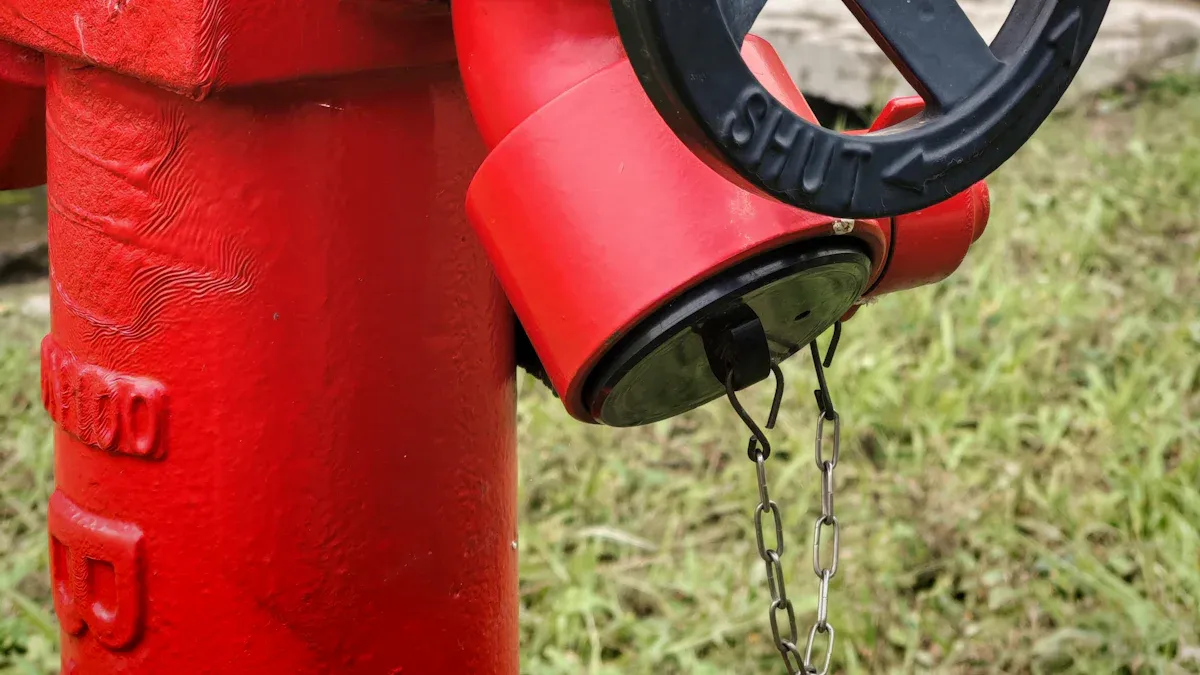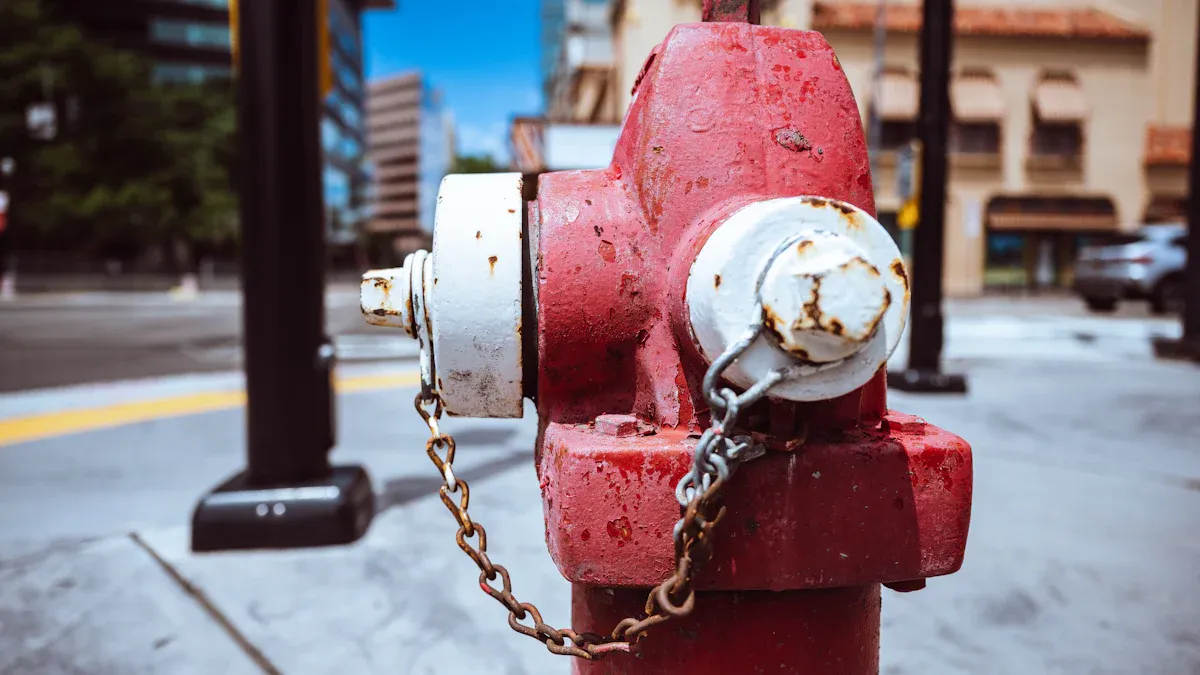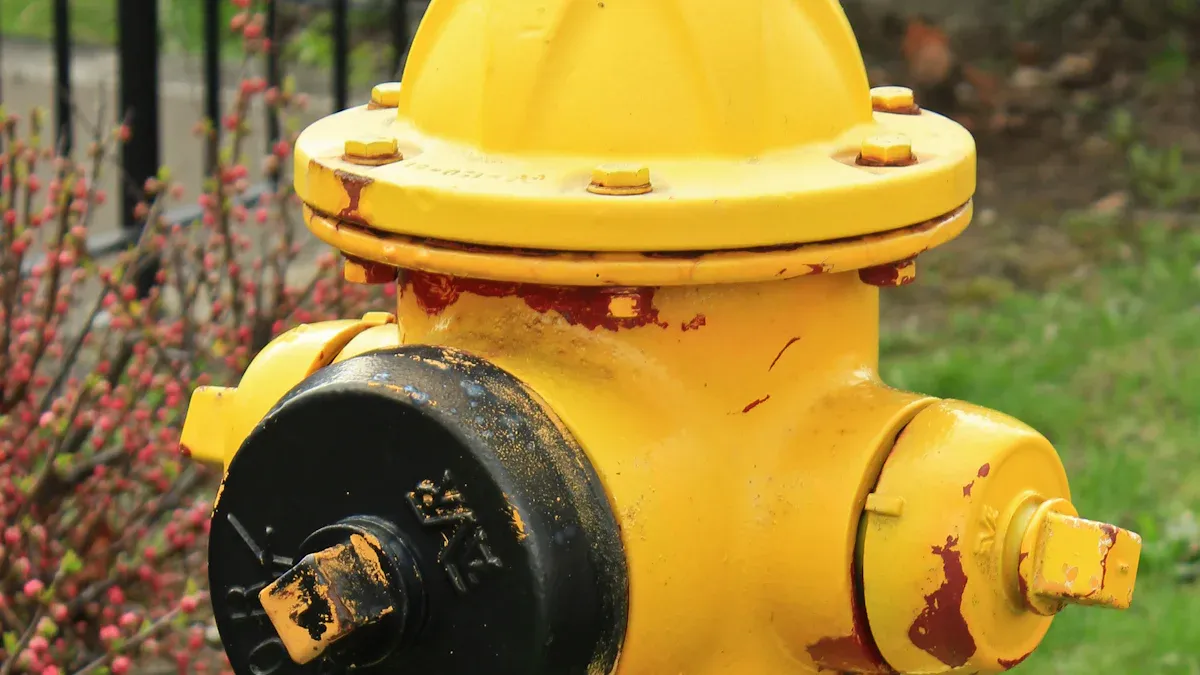
Pressure Regulating Valves (PRVs) are essential components in urban fire hydrant systems, playing a crucial role in optimizing water pressure to ensure reliable operation during emergencies. These systems, including fire hydrants and fire hydrant valves, benefit greatly from the use of PRVs, as they help prevent infrastructure damage and minimize water wastage. For example, reducing water pressure by 60 psi can decrease annual leakage from 189 million gallons to 80 million gallons. Additionally, pressure restricting valves and pressure regulating valves improve technical performance indicators, boosting efficiency from 79.81% to 97.45%. With an average installation cost of $500,000 and a payback period of just 2-4 years, PRVs provide a cost-effective solution for municipalities. Yuyao World Fire Fighting Equipment Factory specializes in delivering high-quality PRV valves, fire hydrant valves, and other firefighting equipment tailored to meet urban needs.
Key Takeaways
- PRV valves stop too much pressure, keeping pipes safe from harm.
- Steady water flow from PRV valves helps firefighters get water fast.
- PRV valves cut down on wasted water, saving it for city needs.
- Cities spend less on repairs and make hydrants last longer with PRV valves.
- PRV valves help cities grow smart by saving water and using less energy.
Enhanced Pressure Control with PRV Valves
Preventing Over-Pressurization
Over-pressurization in urban fire hydrant networks can lead to severe consequences, including pipe bursts and damage to critical infrastructure. PRV valves play a pivotal role in mitigating these risks by regulating water pressure effectively. By maintaining pressure within safe limits, these valves prevent sudden surges that could compromise the integrity of the system. This ensures the longevity of pipes and hydrants, reducing the likelihood of costly repairs or replacements.
In addition, PRV valves enhance the safety of surrounding areas. Excessive pressure can cause leaks or bursts that may damage nearby roads and buildings. By controlling pressure levels, PRV valves protect urban infrastructure and contribute to a safer environment for residents. Their ability to prevent over-pressurization makes them an indispensable component of modern firefighting systems.
Maintaining Optimal Water Flow
Maintaining consistent water flow is essential for the efficient operation of fire hydrant networks. PRV valves ensure that water pressure remains stable, even during peak demand or emergency situations. This stability allows firefighters to access a reliable water supply when responding to fires, improving their ability to control and extinguish flames quickly.
Research highlights the effectiveness of PRV valves in optimizing water flow. Studies show that proper placement and adjustment of these valves can reduce pressure fluctuations by 56.12% compared to systems without PRVs. This optimization not only enhances the performance of the network but also minimizes water wastage. By maintaining optimal flow, PRV valves support the sustainability of urban water systems while ensuring readiness for emergencies.
Yuyao World Fire Fighting Equipment Factory offers high-quality PRV valves designed to meet the demands of urban fire hydrant networks. Their products provide reliable pressure control, ensuring the safety and efficiency of firefighting infrastructure.
Improved Firefighting Efficiency Through PRV Valves

Ensuring Consistent Water Supply
A consistent water supply is critical for effective firefighting operations, especially in urban environments. PRV valves regulate water pressure to ensure a steady flow, even in areas with fluctuating demand. This reliability allows firefighters to focus on extinguishing fires without worrying about sudden drops in water availability. By maintaining discharge pressures between 70 and 90 psi, PRV valves overcome friction loss in pipes, ensuring water reaches its destination with sufficient force. This capability is particularly vital in high-rise buildings, where water delivery to upper floors can be challenging.
The importance of PRV valves became evident after the One Meridian Plaza fire, which highlighted the need for reliable pressure regulation in high-rise firefighting. Training programs, such as those conducted by DFD District #3, emphasize the role of PRVs in reducing delays in water delivery. These valves ensure that firefighters can combat rapid fire growth effectively, even in complex urban settings.
Supporting High-Pressure Demands During Emergencies
Emergencies often require water systems to handle sudden surges in demand. PRV valves excel in these situations by maintaining stable pressure levels, preventing system overloads. This stability ensures that hydrants deliver water at the required pressure, enabling firefighters to operate hoses and equipment efficiently. Without PRV valves, pressure imbalances could hinder firefighting efforts, especially during large-scale incidents.
Urban firefighting strategies rely on PRV valves to address high-pressure demands in challenging scenarios. For example, flow testing in Denver demonstrated how PRVs maintain optimal pressure levels, ensuring effective water delivery during emergencies. These valves also play a crucial role in protecting infrastructure by preventing over-pressurization, which could damage pipes and disrupt firefighting operations. By supporting high-pressure demands, PRV valves enhance the overall efficiency of urban fire hydrant networks.
Increased Safety for Urban Infrastructure Using PRV Valves
Reducing Risk of Pipe Bursts
Pipe bursts in urban fire hydrant networks can cause significant damage, disrupt water supply, and lead to costly repairs. PRV valves play a crucial role in mitigating this risk by regulating water pressure within safe limits. Excessive pressure often stresses pipes, especially in older systems, making them prone to sudden failure. By maintaining consistent pressure, PRV valves prevent these dangerous surges, ensuring the integrity of the entire network.
The ability of PRV valves to reduce pipe bursts also minimizes water wastage. A single burst can release thousands of gallons of water, depleting resources and increasing operational costs for municipalities. With PRV valves in place, urban water systems operate more efficiently, conserving water and reducing the likelihood of emergency repairs. This proactive approach not only protects infrastructure but also supports sustainable urban development.
Protecting Surrounding Buildings and Roads
Uncontrolled water pressure can have a ripple effect, causing damage beyond the fire hydrant network. High-pressure surges may lead to leaks or bursts that compromise nearby roads, sidewalks, and even building foundations. PRV valves act as a safeguard, ensuring that pressure fluctuations do not extend their impact to surrounding structures.
In densely populated urban areas, this protection is especially critical. Roads and buildings are often in close proximity to fire hydrants, making them vulnerable to water-related damage. PRV valves help maintain the stability of these structures by preventing sudden pressure changes. This not only reduces repair costs but also enhances public safety by minimizing the risk of accidents caused by infrastructure failures.
Yuyao World Fire Fighting Equipment Factory offers PRV valves designed to meet the unique challenges of urban environments. Their products ensure reliable pressure control, protecting both fire hydrant systems and the surrounding infrastructure.
Prolonged Lifespan of Fire Hydrant Systems with PRV Valves
Minimizing Wear and Tear on Pipes
Urban fire hydrant systems face constant pressure fluctuations, which can lead to significant wear and tear on pipes over time. A PRV Valve plays a critical role in mitigating this issue by maintaining consistent water pressure throughout the network. By preventing sudden pressure surges, it reduces the mechanical stress exerted on pipes, joints, and fittings. This not only preserves the structural integrity of the system but also minimizes the risk of leaks and failures.
Studies have shown that systems equipped with PRV Valves experience up to 40% less pipe degradation compared to those without pressure regulation. This reduction in wear and tear translates to fewer emergency repairs and a more reliable firefighting infrastructure. In addition, the controlled pressure environment created by these valves ensures that older pipes, which are more susceptible to damage, remain functional for longer periods.
Reducing Maintenance Costs
The implementation of PRV Valves significantly lowers maintenance costs for municipalities. By reducing the frequency of pipe bursts and leaks, these valves decrease the need for costly emergency repairs. Scheduled maintenance becomes more predictable and less resource-intensive, allowing municipalities to allocate their budgets more effectively.
For example, a city that integrates PRV Valves into its fire hydrant network can save thousands of dollars annually on repair expenses. These savings stem from the reduced need to replace damaged pipes and the minimized labor costs associated with emergency interventions. Furthermore, the extended lifespan of the system components means that municipalities can delay large-scale infrastructure upgrades, further optimizing their financial resources.
By investing in high-quality PRV Valves, such as those offered by Yuyao World Fire Fighting Equipment Factory, urban areas can achieve long-term cost savings while ensuring the reliability of their firefighting systems.
Cost Savings for Municipalities Enabled by PRV Valves
Lower Repair and Replacement Costs
Municipalities often face high expenses due to frequent repairs and replacements in urban fire hydrant networks. The implementation of a PRV Valve significantly reduces these costs by minimizing the risk of pipe bursts and leaks. By maintaining consistent water pressure, the valve prevents excessive stress on pipes, which is a leading cause of infrastructure failure. This proactive approach ensures that the system operates efficiently, reducing the need for emergency interventions.
A comparison of repair and replacement statistics before and after PRV Valve implementation highlights its impact:
| Metric | Before PRV Implementation | After PRV Implementation |
|---|---|---|
| Annual Leakage (million gallons) | 189 | 80 |
| Annual Breaks | 65 | 32 |
The table demonstrates a significant decrease in both annual leakage and pipe breaks, showcasing the cost-saving potential of PRV Valves. These reductions translate into lower repair bills and fewer disruptions to essential services, allowing municipalities to allocate resources more effectively.
Improved Resource Allocation
Efficient resource allocation is critical for municipalities managing urban infrastructure. PRV Valves contribute to this efficiency by reducing the frequency of maintenance and repair tasks. With fewer emergencies to address, municipal teams can focus on long-term planning and system upgrades. This shift not only improves operational efficiency but also enhances the overall reliability of fire hydrant networks.
The cost savings achieved through reduced maintenance enable municipalities to invest in other critical areas, such as expanding hydrant networks or upgrading outdated equipment. By optimizing resource allocation, PRV Valves support sustainable urban development and ensure that firefighting systems remain prepared for emergencies.
Yuyao World Fire Fighting Equipment Factory provides high-quality PRV Valves designed to meet the unique needs of urban environments. Their products help municipalities achieve significant cost savings while maintaining reliable firefighting infrastructure.
Enhanced Water Conservation with PRV Valves

Reducing Water Wastage from Leaks
Water wastage poses a significant challenge in urban fire hydrant networks. Pressure management through a PRV Valve plays a vital role in addressing this issue. By regulating water pressure, these valves minimize the stress on pipes, reducing the likelihood of leaks and bursts. Lower pressure levels also decrease the flow rate through existing cracks or holes, effectively curbing water loss.
- Pressure management directly impacts water loss rates. Increased pressure often leads to higher pipe failure rates, exacerbating water wastage.
- Properly designed pressure zones reduce leaks, as leakage decreases exponentially with lower pressure. This approach also results in fewer pipe breaks and lower pumping costs.
By implementing PRV Valves, municipalities can achieve substantial water conservation. These valves not only prevent unnecessary water loss but also enhance the efficiency of urban water systems. This proactive measure ensures that valuable resources are preserved for future use.
Promoting Sustainable Urban Development
Sustainable urban development relies on efficient resource management. PRV Valves contribute to this goal by optimizing water usage in fire hydrant networks. Reduced leaks and controlled pressure levels ensure that water is used responsibly, supporting the long-term sustainability of urban areas.
In addition to conserving water, PRV Valves lower energy consumption. Reduced pressure levels decrease the workload on pumps, leading to significant energy savings. This reduction in energy use aligns with global efforts to minimize carbon footprints and combat climate change.
Municipalities that prioritize sustainable practices benefit from the integration of PRV Valves. These valves not only enhance the reliability of firefighting infrastructure but also promote environmental stewardship. By investing in high-quality PRV Valves, such as those offered by Yuyao World Fire Fighting Equipment Factory, cities can achieve their sustainability goals while ensuring the safety and efficiency of their water systems.
Adaptability to Urban Growth Supported by PRV Valves
Supporting Expanding Hydrant Networks
Urban areas experience continuous growth, requiring fire hydrant networks to expand and adapt to new demands. PRV valves play a vital role in supporting this expansion by ensuring consistent pressure management across larger networks. As cities grow, the complexity of hydrant systems increases, making reliable pressure regulation essential for maintaining operational efficiency.
Modern urban networks rely on advanced systems like SCADA (Supervisory Control and Data Acquisition) to monitor and manage PRV valve settings. These systems collect and transmit real-time data on valve status and pressure levels, enabling municipalities to address fluctuations promptly. Accurate data collection ensures that PRV valves maintain optimal pressure, preventing infrastructure damage and ensuring reliable water delivery during emergencies. Case studies highlight the importance of reviewing PRV settings and investigating SCADA issues to ensure seamless integration into expanding networks. This proactive approach supports urban growth while maintaining the integrity of firefighting systems.
Managing Increased Water Demand
Population growth and urban development lead to higher water demand, particularly in densely populated areas. PRV valves help manage this increased demand by maintaining constant downstream pressure, even when upstream conditions fluctuate. This stability ensures that fire hydrants deliver water efficiently, reducing the risk of shortages during emergencies.
Pressure regulation also minimizes water wastage, conserving resources and reducing operational costs. Lower pressure levels decrease leakage rates, cutting annual water loss from 189 million gallons to 80 million gallons. This reduction not only conserves water but also extends the lifespan of pipes and hydrants by reducing stress on infrastructure. PRV valves further optimize water usage by lowering flow rates, which decreases overall consumption and supports sustainable urban development.
Municipalities benefit from the cost-effectiveness of PRV valves, particularly in high-demand areas like urban high-rise districts. With a payback period of two to four years, these valves provide a practical solution for managing water demand while ensuring reliable firefighting infrastructure.
Compliance with Safety Standards Using PRV Valves
Meeting Regulatory Requirements
Urban fire hydrant networks must comply with stringent safety standards to ensure reliable performance during emergencies. PRV valves play a critical role in meeting these regulatory requirements by maintaining consistent water pressure and safeguarding infrastructure. Regular inspections and testing protocols ensure that these valves operate as intended, contributing to the overall safety of urban water systems.
Industry standards recommend conducting quarterly inspections to verify that inlet and outlet pressures align with operational requirements. These inspections also confirm that valves remain in the correct open or closed position, handwheels are intact, and hose threads are in good condition. Annual partial flow testing ensures that the valve seat moves from the closed position, while a full flow test every five years evaluates the valve’s overall functionality. These practices demonstrate the reliability of PRV valves in adhering to safety regulations and maintaining system integrity.
Enhancing Public Trust in Infrastructure
Public trust in urban infrastructure depends on the consistent performance of critical systems like fire hydrant networks. PRV valves enhance this trust by ensuring that water pressure remains stable, even during emergencies. Their ability to prevent over-pressurization and minimize water wastage reassures residents that the system is both efficient and sustainable.
Transparent compliance with safety standards further strengthens public confidence. When municipalities implement regular testing and maintenance protocols, they demonstrate a commitment to safety and reliability. This proactive approach not only reduces the risk of system failures but also fosters trust among residents and stakeholders. By integrating PRV valves into fire hydrant networks, cities can uphold high safety standards while reinforcing public confidence in their infrastructure.
Simplified System Monitoring and Maintenance with PRV Valves
Enabling Remote Pressure Monitoring
Modern urban fire hydrant networks require efficient monitoring systems to ensure consistent performance. A PRV Valve facilitates remote pressure monitoring, enabling municipalities to oversee water pressure levels in real time. This capability reduces the need for manual inspections, saving time and resources. Advanced technologies, such as Supervisory Control and Data Acquisition (SCADA) systems, integrate seamlessly with PRV Valves. These systems collect and transmit data, allowing operators to identify pressure fluctuations or potential issues instantly.
Remote monitoring enhances the reliability of firefighting infrastructure. Operators can respond to anomalies before they escalate into significant problems. For example, a sudden drop in pressure might indicate a leak, while a spike could signal a blockage. Addressing these issues promptly minimizes disruptions and ensures the system remains operational during emergencies. By leveraging remote monitoring, municipalities improve system efficiency and reduce the risk of costly repairs.
Streamlining Maintenance Processes
PRV Valves simplify maintenance processes by reducing the frequency of emergency repairs. Their ability to regulate pressure minimizes wear and tear on pipes, joints, and other components. This proactive approach ensures that routine maintenance tasks are more predictable and less labor-intensive. Municipalities can schedule inspections and repairs during non-peak hours, minimizing disruptions to essential services.
In addition, PRV Valves support condition-based maintenance strategies. Operators can use data from remote monitoring systems to determine when specific components require attention. This targeted approach eliminates unnecessary maintenance, optimizing resource allocation. For instance, instead of replacing an entire section of piping, technicians can focus on areas showing signs of stress or degradation. This efficiency reduces operational costs and extends the lifespan of the fire hydrant network.
Yuyao World Fire Fighting Equipment Factory offers high-quality PRV Valves designed to enhance system monitoring and streamline maintenance. Their products ensure reliable pressure control, supporting the long-term sustainability of urban firefighting infrastructure.
Contribution to Emergency Preparedness Through PRV Valves
Ensuring Readiness for Large-Scale Fires
Urban areas face significant risks from large-scale fires, especially in densely populated regions. A PRV Valve plays a critical role in ensuring that fire hydrant networks remain operational during such emergencies. By maintaining consistent water pressure, these valves provide firefighters with a reliable water supply, enabling them to respond effectively to rapidly spreading fires.
The importance of valves in emergency preparedness became evident in 2017 when an explosion occurred due to a damaged or improperly closed valve. This incident highlighted the need for robust pressure regulation systems to prevent catastrophic failures. Additionally, emergency relief systems designed using advanced tools, such as adiabatic reaction calorimeters, simulate upset scenarios to prepare for large-scale fires. These simulations help municipalities optimize PRV Valve settings, ensuring readiness for high-pressure demands during emergencies.
Supporting Disaster Response Efforts
Disaster response requires infrastructure that can adapt to sudden and extreme conditions. PRV Valves enhance the resilience of fire hydrant networks by preventing over-pressurization and ensuring stable water flow. This reliability allows emergency teams to focus on containment and recovery efforts without worrying about system failures.
During disasters, such as industrial fires or natural calamities, PRV Valves safeguard critical infrastructure by regulating pressure surges. This protection minimizes the risk of pipe bursts, which could disrupt water supply and hinder firefighting operations. Furthermore, the ability to maintain optimal pressure levels ensures that water reaches even the most remote or elevated areas, supporting comprehensive disaster response strategies.
By integrating PRV Valves into urban fire hydrant networks, municipalities strengthen their emergency preparedness and enhance their ability to respond to large-scale incidents effectively.
PRV valves serve as a cornerstone for urban fire hydrant networks, ensuring safety, efficiency, and cost-effectiveness. Their ability to regulate water pressure enhances the reliability of firefighting systems, reducing risks to infrastructure and conserving resources. Municipalities that invest in these valves benefit from long-term savings and improved emergency preparedness.
Yuyao World Fire Fighting Equipment Factory delivers high-quality PRV valves tailored to meet the unique demands of urban environments. Their products support sustainable urban development while maintaining the integrity of critical infrastructure.
FAQ
What is the primary function of a PRV valve in fire hydrant networks?
A PRV valve regulates water pressure to prevent over-pressurization. It ensures consistent water flow, protects infrastructure, and enhances the efficiency of firefighting systems. This makes it an essential component of urban fire hydrant networks.
How do PRV valves contribute to water conservation?
PRV valves minimize water wastage by reducing leaks and bursts caused by excessive pressure. They also lower flow rates through existing cracks, conserving water resources and supporting sustainable urban development.
Can PRV valves handle high-pressure demands during emergencies?
Yes, PRV valves maintain stable pressure levels even during sudden surges in demand. This ensures hydrants deliver water at the required pressure, enabling firefighters to operate effectively in large-scale emergencies.
How do PRV valves reduce maintenance costs for municipalities?
PRV valves prevent pipe bursts and leaks by regulating pressure. This reduces the frequency of emergency repairs and extends the lifespan of infrastructure, lowering overall maintenance expenses for municipalities.
Are PRV valves suitable for expanding urban hydrant networks?
PRV valves adapt well to expanding networks by ensuring consistent pressure management. They integrate with advanced monitoring systems like SCADA, enabling municipalities to maintain operational efficiency as urban areas grow.
Post time: May-08-2025

